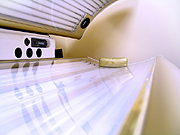| Home A B C D E F G H I J K L M N O P Q R S T U V W X Y Z |
|
Home |
Understanding the Dangers of Tanning Beds
When it comes to getting a tan in a tanning bed, there is much controversy. For starters, people across the country have been building golden tans for several decades. While a tanned body is attractive, the problem is that there are also many tanning bed dangers, some that people know of and some that are hidden. Today, tanning salons account for a $5 billion a year industry that just keeps on growing. If you were to look at commercials, magazine advertisements, and many high society people, you see toned and tanned bodies. However, all of this is merely portraying a false sense of health and beauty. In truth, tanning beds can be very dangerous, causing burns, suppression of immune systems, damage to the cornea, cosmetic and drug-induced photosensitivity, and a higher risk of developing melanoma cancer. Because there are no laws governing the use of tanning beds, people are free to use them as long and as often as they like. Keep in mind that the majority of tanning salons do have restrictions about usage but these are rules set up by the salon, not the government. Sadly, we see teenagers having restrictions on them for smoking cigarettes, which cause cancer, yet the tanning bed that has also been proven to increase the risk of cancer has no such structure. The bottom line is that every person interested in developing a tan via indoor tanning needs to have a full understanding of tanning bed dangers so they can make educated and safe choices. For example, most tanning beds release very high and dangerous levels of ultraviolet radiation, which has been shown through massive testing to cause premature aging while increasing the risk of skin cancer. Additionally, using indoor tanning on a short-term basis commonly causes itchy, dry skin while long-term use causes wrinkled and sagging skin. Making things more difficult is the fact that many people also take tanning accelerants as a way of speeding up the tanning process. However, these accelerants contain tyrosine derivatives and amino acid tyrosine, both which are ineffective and have the possibility of being dangerous. Even so, manufacturers push these products while the Food and Drug Administration has not approved them. Without doubt, tanning beds have become an extremely popular option for maintaining a tan throughout the year. Just remember that in exchange for the golden glow, the body is negatively affected. In fact, because tanning beds emit from 50% to 100% the amount of UV rays than from natural sunlight, you would be safer lying out on the beach for a few hours. If you want to tan, be wise about the amount of time spent and the frequency of using indoor tanning beds. About The Author |
|
|
|
|
|
Glossary References Links Contact
|